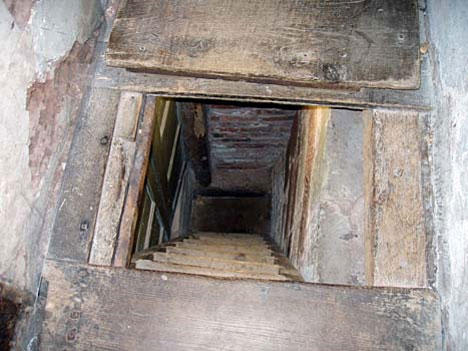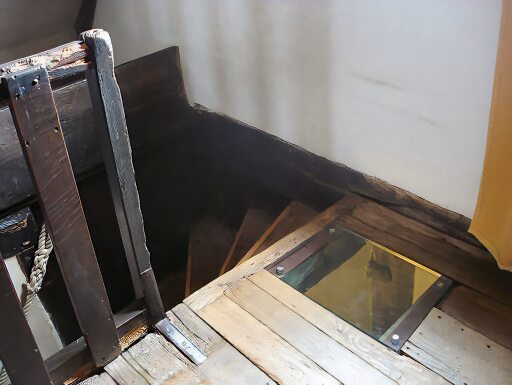Priest Holes
Under the reign of "Good Queen Bess", a law was passed prohibiting the celebration of Mass, on pain of extradition. On a second offense, the guilty priest would be sentenced to a year in prison, and on the third offense, jailed for life. In some cases, the offending priest would be put to death, usually by hanging, drawing, and quartering. Another law was passed that punished with death any Catholic who should convert a Protestant.
It was during this time that the Jesuit and martyr Nicholas Owen was called on to design and build priest holes in all the great Catholic manses in England. He spent the greater part of his life doing so.
Brother Owen was caught and tortured on the rack. Asked to reveal all the hiding places he had built, he refused, and died in the midst of his torments.
Some of the following were built by Br. Owen, while others' origins are unknown.
Harvington Hall

A false fireplace leads into the attic.


Another priest hole can be found under the slats of the staircase.

A floorboard to the left of the altar can be lifted and used to hide the instruments for Mass.
Naworth Castle (video)
According to the website:
Oxburgh Hall also has a lovely library with a secret door masquerading as a wall of shelves. At one point, the house was seized from the recusant Catholic family, and later returned. One of the dummy books in the false door bears the title "Rewards for Sir Henry Bedingfeld, His Loyaltie," indicating not a little resentment over the family's treatment by the Crown.

One of the secret panels at Ufton Court.

Wymering Manor

Priest hole at Boscobel House, which famously hid a monarch: Charles II, who it is said converted to Catholicism on his deathbed.

Harvington Hall priest hole hidden behind wooden beam.
These are only a handful of the dozens of priest holes scattered all throughout England, constant reminders of the sacrifice and courage of these men of God who risked their lives to bring Our Lord to the persecuted faithful.
It was during this time that the Jesuit and martyr Nicholas Owen was called on to design and build priest holes in all the great Catholic manses in England. He spent the greater part of his life doing so.
With incomparable skill, he knew how to conduct priests to a place of safety along subterranean passages, to hide them between walls and bury them in impenetrable recesses, and to entangle them in labyrinths and a thousand windings. But what was much more difficult of accomplishment, he so disguised the entrances to these as to make them most unlike what they really were. Moreover, he kept these places so close a secret with himself that he would never disclose to another the place of concealment of any Catholic. He alone was both their architect and their builder, working at them with inexhaustible industry and labour, for generally the thickest walls had to be broken into and large stones excavated, requiring stronger arms than were attached to a body so diminutive as to give him the nickname of 'Little John,' and by this his skill many priests were preserved from the prey of persecutors. Nor is it easy to find anyone who had not often been indebted for his life to Owen's hiding-places.--Fr. Tanner, Vita et Mors
Brother Owen was caught and tortured on the rack. Asked to reveal all the hiding places he had built, he refused, and died in the midst of his torments.
Some of the following were built by Br. Owen, while others' origins are unknown.
Harvington Hall

A false fireplace leads into the attic.


Another priest hole can be found under the slats of the staircase.

A floorboard to the left of the altar can be lifted and used to hide the instruments for Mass.
Naworth Castle (video)
According to the website:
the Naworth Castle pries thole may have been built during the time of Lord William Howard (1563-1640) who lived through The Reformation. Imprisoned no less than three times on suspicion of treason whilst still in his 20's and having seen his father Thomas Howard executed in 1572, William Howard was only too well aware of the dangers of being a practising Catholic in England at that time. He lived at Naworth Castle with his family from 1602 until shortly before his death. The priest hole can be found behind the panelling of the chapel in what is known as Lord William's Tower.Oxburgh Hall (video)
Oxburgh Hall also has a lovely library with a secret door masquerading as a wall of shelves. At one point, the house was seized from the recusant Catholic family, and later returned. One of the dummy books in the false door bears the title "Rewards for Sir Henry Bedingfeld, His Loyaltie," indicating not a little resentment over the family's treatment by the Crown.

One of the secret panels at Ufton Court.

Wymering Manor

Priest hole at Boscobel House, which famously hid a monarch: Charles II, who it is said converted to Catholicism on his deathbed.
Harvington Hall priest hole hidden behind wooden beam.
These are only a handful of the dozens of priest holes scattered all throughout England, constant reminders of the sacrifice and courage of these men of God who risked their lives to bring Our Lord to the persecuted faithful.

<< Home